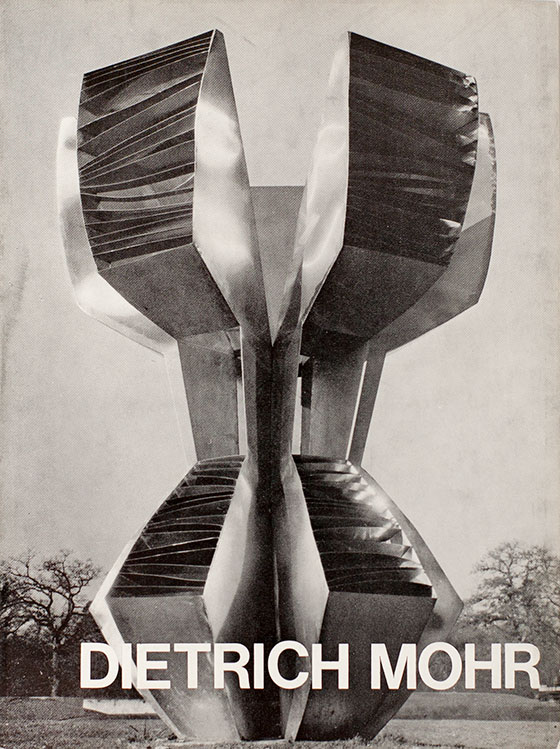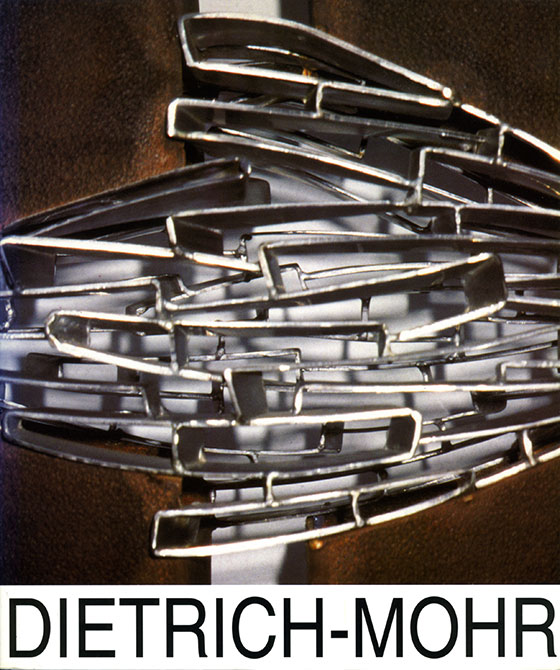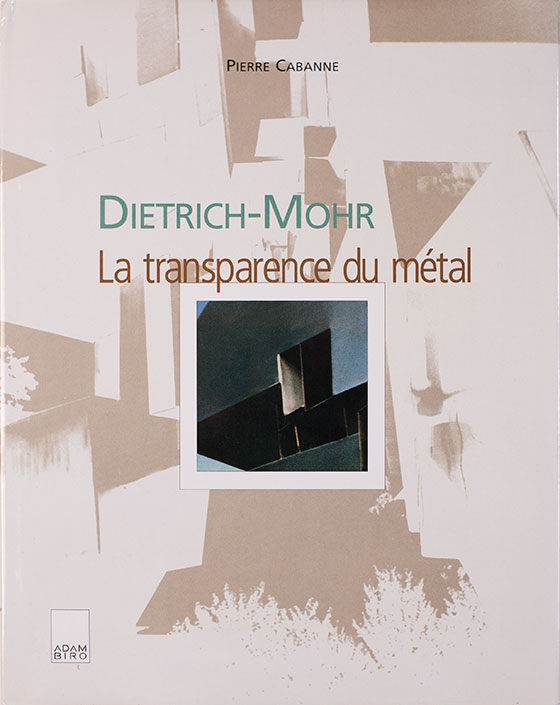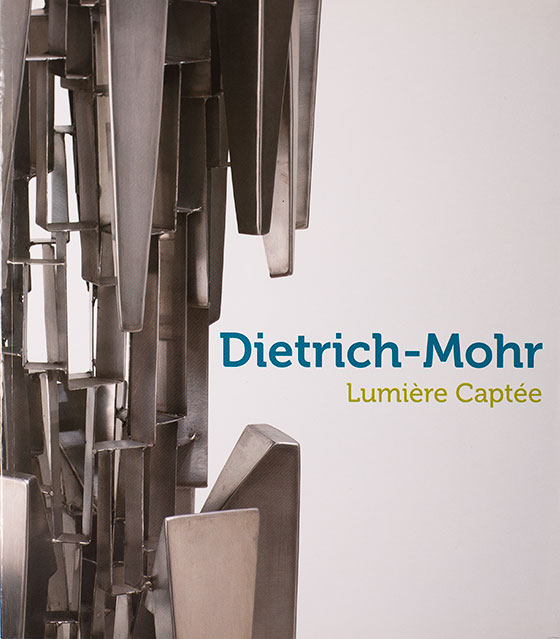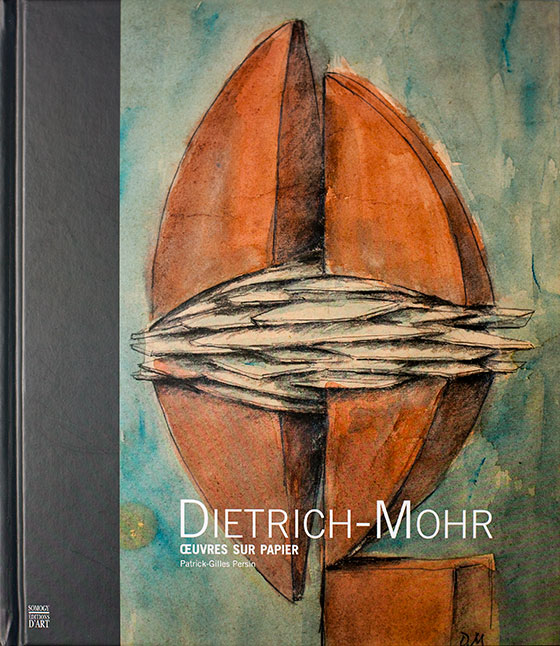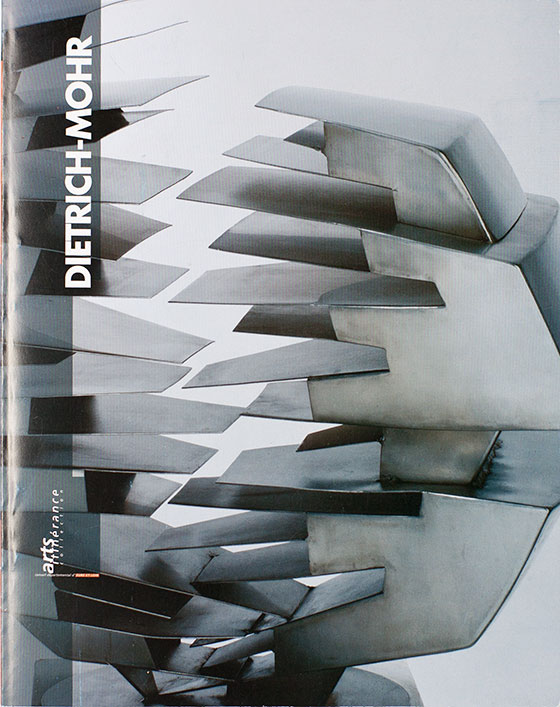Monographies
3 major books, 5 catalogues and 1 pocket book:
1975
«Dietrich-Mohr» by Denys Chevalier, Ed. Arted, (pocket book)
1989
«Dietrich-Mohr» by Jean-Loup Bézos, Ed. La Différence (catalogue)
2001
« Trace et volume » by Patrick-Gilles Persin, l’Espace Culturel de l’Auditoire, Bonneval, France, Conseil Général Eure-et-Loir (catalogue)
2001
«La Transparence du métal» by Pierre Cabanne, Ed. Adam Biro (lbook)
2011
«Lumière Captée» by Bernard Fauchille (Musée d’Evreux), Ed. Point de vues (book with inventory)
2012
«Oeuvres sur papier» by Patrick-Gilles Persin, Ed. Somogy (book)
2015
Dietrich-Mohr, « l’Univers du Métal » by Lydia Harambourg, l’Eurélium, Conseil Départemental de l’Eure-et-Loir (catalogue)
Main catalogues for personal exhibitions
1963
Denys Chevalier, DIETRICH-MOHR, Galerie de l’Université, Paris
1977-1978
Maurice Allemand, Françoise Maison, Annick Pely, DIETRICH-MOHR, Itinerant exhibition
1979
Gérard Xuriguera, DIETRICH-MOHR, Musées de Metz, France
1979
Gérard Xuriguera, DIETRICH-MOHR, Galerie Bruck, Luxembourg
1981
Pierre Cabanne, DIETRICH-MOHR, Galerie Bellint, Paris
1982
François Wehrlin, DIETRICH-MOHR, Maison de la Culture, Orléans, France
1991
Meinrad M. Grewenig, DIETRICH-MOHR, Treffpunkt Kunst , Museum Haus Ludwig, Saarlouis, Germany
1997
Jean-Pierre Bretegnier, DIETRICH-MOHR, Maison des Arts et Loisirs, Sochaux, France
2001
Patrick-Gilles Persin, DIETRICH-MOHR « Trace et volume », l’Espace Culturel de l’Auditoire, Bonneval, France
2002
Jacques Boyon, DIETRICH-MOHR « Lumière de métal » Maison des Princes, Pérouges, France
2004
Gérard Xuriguera, DIETRICH-MOHR « Un voyage au cœur de la forme », Château de Carrouges, France
2012
Patrick-Gilles Persin, DIETRICH-MOHR, Galerie F. Hessler, Luxembourg
2015
Lydia Harambourg, DIETRICH-MOHR, l’Eurélium, Conseil Départemental, Chartres, France
Films and video
Jean-Luc Bruandet, 1er Symposium de la Forêt de Sénart, film realized pour l’Office National des Forêts, 1971.
Jacques Verrier, DIETRICH-MOHR, film, Difart 1983-84.
DIETRICH-MOHR – SCULPTEUR, video realized par le DPA, Ministère des Finances 1995.
Christine Jami Longuépée, Le pont de Gratteloup de Dietrich-Mohr, Jour d’Eclipse, 2001.
DIETRICH-MOHR, video, Encyclopédie audiovisuelle de l’art contemporain, IMAGO, 2002.
ARTICLES IN REVIEWS AND THE PRESS ON DIETRICH-MOHR by :
Serge AIRULDI, Elisabeth BENACCIO, Claudine BONI, Pierre BRISSET, Pierre CABANNE, Denys CHEVALIER, Muriel CLUSEAU-CIRY, Dominique DALEMONT, Jean-Marie DUNOYER, François EON, Jean-Luc EPIVENT, Lydia HARAMBOURG, Pierre HENRY, Gil HEZO, Didier JOLY, Pierre JOSSE, Christophe JOUAN, Lucien KAYSER, Ph. KIENTZY, Jacques LEPAGE, Jean-Jacques LEVÈQUE, Bernard MARTIN, Anna Luise MATHIEU, Marie-Thérèse MATHIEU, Françoise MONNIN, Raoul-Jean MOULIN, Joseph-Emile MULLER, Elly NEUMANN-BAUMERT, Annick PELY, Patrick-Gilles PERSIN, François PLUCHART, Luis PORQUET, Emmanuelle ROY, Wolfgang SAURE, Gérald SCHURR, Geneviève-Morgane TANGUY, Sabine TARI-LEGUAY, Jean-Marie TASSET, René VIGO, Janine WARNOD, Gerhard WEBER, etc.
General works
1970
Nouveau Dictionnaire de la Sculpture Moderne, Editions Hazan, Paris
1974
Michel Ragon et Michel Seuphor, L’Art Abstrait, Editions Maeght, Paris
1976
Le Dictionnaire de E. Bénézit, Paris
1982
Ionel Jianou, La Sculpture Moderne en France depuis 1950, Editions d’Art, Arted, Paris
1984
Gérard Xuriguera, Les Années 50, Editions d’Art Arted, Paris
1990
Geneviève-Morgan Tanguy, Ailleurs en Loir-et-Cher, D.H.R., Blois, France
1993
Robert Moran, Le Dessin, Editions Fleurus, Paris
1994
Hervé Béchy, ART / LYCEES 1951-1993, Conseil Régional, Paris
1997
Patrick Morisson, Artistes in situ, Danilo Montanari Editore Ravenne
Variations sur inox, Association Cantonale d’Animation de Gueugnon,
2000
Pierre Cabanne, Le Dictionnaire des Arts, Editions de l’Amateur, Paris
2003
«Treffpunkt Kunst – 25 Jahre», Editions Bernhard et Ursula Giebel, Saarlouis, Germany
2006
Dominique Dalemont, Les Sculpteurs du Métal, Editions Somogy Editions d’Art, Paris
2007
Lydia Harambourg, 41 Sculpteurs, Somogy Editions d’Art, Paris
2008
Marie-Paule Nègre, “Des artistes en leur monde”, La Gazette de l’Hôtel Drouot, Paris
Satoru Sato Art Museum, Tome City, Japan
Gérard Xuriguera, Regard sur la sculpture contemporaine, Editions FVW, Paris
Aspect de l’art en France (1950-1970), La Collection Maurice Allemand, Musée Départemental de l’Oise, Somogy Editions d’Art, Paris
2009
Lydia Harambourg, 73 Sculpteurs, Somogy Editions d’ Art, Paris
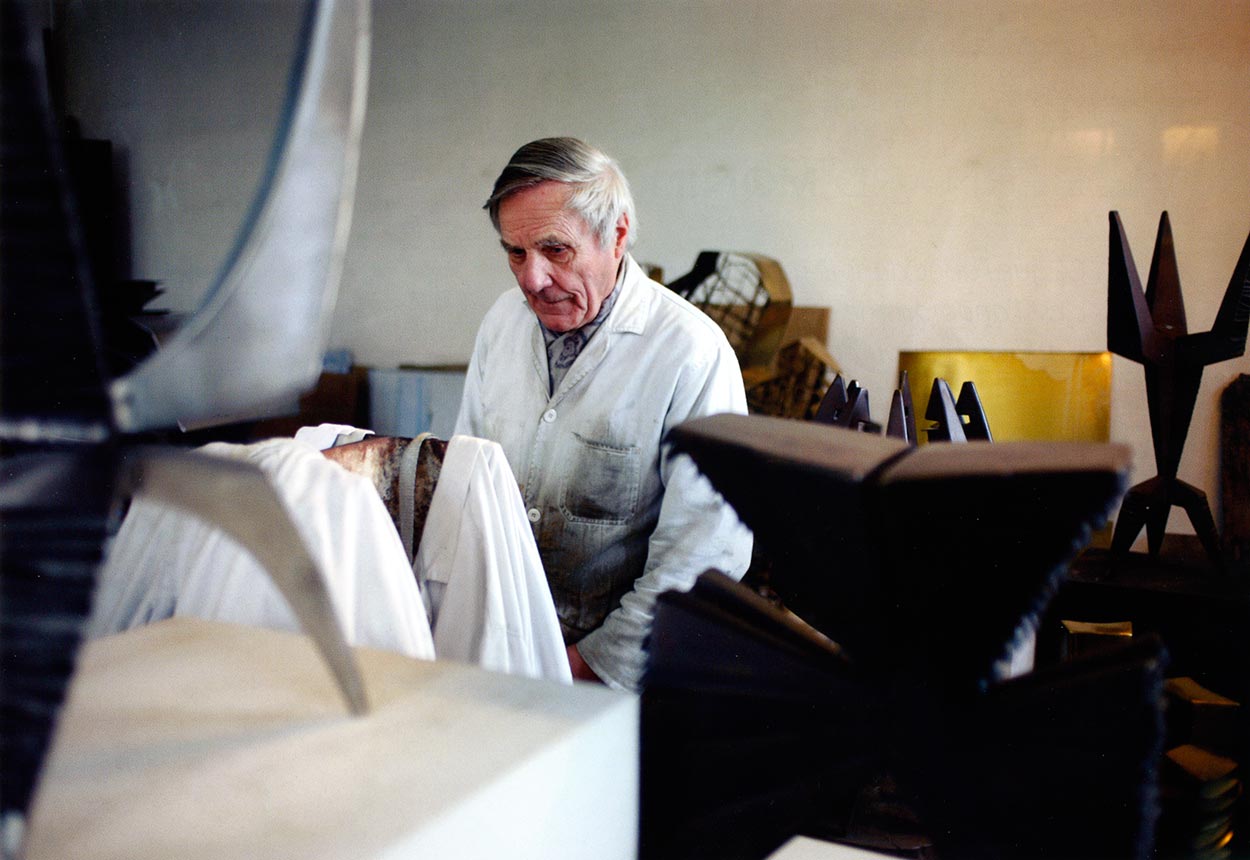
Citations
His metal sculptures – transparencies, lamelliforms, alveoli, and unstable equilibriums – demonstrate a desire to construct, in a spirit of order and measurement, harmonious ensembles, remarkable for their invented language, for their technical innovation and by the creative use of light as a constituent element of the composition. The sculpture of DIETRICH-MOHR thus provokes an emotion and acquires a human dimension.
Denys Chevalier, DIETRICH-MOHR, Actualité de la Sculpture, ARTED, Editions d’Art, Paris
DIETRICH-MOHR has created a personal language all his own, making his sculpture immediately identifiable. From very early on, his unique style has made him stand out in the world of post-war sculpture, with the creation in particular of numerous monumental sculptures. Responding in his own way to the problems posed by new metal assembly techniques, he gives a new take on modernity through his use of plastics and expressions of brass, stainless steel, cor-ten. These he uses in a creative process rooted in orthogonality which curbs every outpouring and interpretive discourse. His creative gesture is based on a premediated approach, often preceded by drawings in ink or pencil, some enhanced by watercolours…
His technical expertise in cutting and welding serves as an expression in the continuity of concise and harmonious sculpture, of an intransigent purity, preferring understatement to discourse for a balanced vision…
The evident presence of his sculpture with its meaningful strength reveals to us the mystical paths of creation. Dietrich-Mohr is a poet as well as a metal sculptor. His uneasy questioning of reality finds answers in his steadfast showdown with metal sculpture. A language that he renders timeless.
Lydia Harambourg,
Correspondent of the Institut de France, Académie des Beaux-Arts.
Catalogue edited for the “L’UNIVERS DU MÉTAL” (World of Metal) exhibition at the Eurélium in Chartres by the Departmental Council of Eure-et-Loir, 2015
A very special force emanates from your sculptures. They touch us, captivate us, sometimes in a quasi oppressive way. Structures very organized, abstract, and at the same time bearer of poetic figurative allusions opening onto an infinite imaginary.
Bernhard Giebel: Personal tribute to his friend Dietrich-Mohr, Preface in catalogue by Peter Lodermeyer: Dietrich-Mohr, 80th birthday.
The constrast between the materials chosen for the external and internal parts of his sculptures is Dietrich-Mohr’s recurring theme.
Apart from the sculptures where these two elements contrast greatly, there are works made up of strata which are architecturally piled up and others which dissolve into alveoles. Here the light not only plays on the differently structured surfaces, but also penetrates through many openings into the interior, thus giving the sculptures their very particular transparency.
Dietrich-Mohr leads the viewer into a universe that makes him feel physically, like an intense haptic sensation, various states in life such as to aspire, to feel well surrounded, to be enlightened, to feel protected, and to accumulate strata of experience which are in fact the fundamental states that forge a human being.
Meinrad Maria Grewenig,
Museum Haus Ludwig, Catalogue “Rendez-vous with Art” Exhibition 1991 in Saarlouis
What Dietrich Mohr’s forms are particularly original for are their constant relationship to the organic, it is the surprising, audacious creation of “biomorphic” forms from an “inorganic” material.
It is difficult to imagine a theme less adapted to sculpture than rain. A subject that, with the possibility of atmospheric representations, lends itself to a pictorial treatment. (…) And yet, rain is a recurring motif in the work of Dietrich-Mohr. “Captured Rain” (1985), “The Rain of the Four Winds” (1985), “Under the Rain” (1986), “Rain Carrousel” (1991) to name but a few titles. (…) The sculptures representing rain consist regularly of oblong lamelae of cor-ten steel, arranged in compact strata. It is easy to recognize the hashed streaks that the rain draws in the sky. But the works of Dietrich-Mohr are not imprisoned by their titles.These titles only give an indication, an impulse to the imagination of the viewer without holding him on a leash or confining him.
Peter Lodermeyer
Catalogue, Dietrich-Mohr, 80th birthday
Saarlouis
This retrospective exhibition “Trace et Volume” (Trace and Volume) of sculptures and drawings by DIETRICH-MOHR is not only devoted to his exemplary works but also celebrates exactly fifty years of his work and life in Paris. The artist arrived there in 1951 and immediately enrolled at the Académie de la Grande Chaumière in Montparnasse and worked in Zadkine’s studio.
The exhibition provides an excellent overview of his works, successfully combining paper and metal, brought together under the alluring title “TRACE et VOLUME”. Even in one of the first bronze sculptures by DIETRICH-MOHR, entitled “Réalité dépassée” (Beyond reality) (1957), the cubist influence was evident. Zadkine’s presence is still very much felt! The road was to be long and fruitful. But can you not feel, here and now, in this piece what the young sculptor was to become? Already the faintest hint of his stamp, his mark was beginning to assert itself. Admittedly, the artist was travelling a very spontaneous path. He knew he was devoted to geometry, to finding a balance in the forms constructed, which he still seeks in his current pieces.
…After a short figurative period, which already heralded the informal, we find ourselves in 1960. His pieces from this time include Limpide (Limpid) (1960) which was a perfect harbinger of the true conceptual appearance of all his future works. The sculpture is composed of metal sheets…
Unquestionably, his work was beginning to assert itself, refine itself and reveal its powerfulness. A few years later, he began to establish a very personal style that would win him universal acceptance and a real reputation for excellence. With “Nuit transfigurée” (Night transfigured) (1963) he took a new approach to the fullness and hollowness without ever allowing light to pass through the work. But already the vertical plates and horizontal strips of zinc (for this piece) used inventive volumes to create a novel world.
The positive and negative had been established. But did DIETRICH-MOHR know then that he had just found the path that would lead him onto the world stage?… He was to continue his search until his works became more open to the light, finally becoming transparent. The backgrounds of the interior partitions disappeared, allowing the sky and nature to sweep through the work giving it a very different dimension, an indisputable spatiality. He attained monumentality; his daring assemblages were superb.
DIETRICH-MOHR’s sculptures are indeed daring. You could even talk about an appetite for risk in terms of the balance, taken to the extreme…
Rigour, intensity, open-mindedness and availability are key qualities for this artist who is in constant search of his own roots and of his ongoing experiences with doubt
Patrick-Gilles Persin
“TRACE et VOLUME” catalogue, Exhibition Espace Culturel de l’Auditoire, Ville de Bonneval, Eure-et Loir 2001
« Drawing is not an exact representaion of the work. It is not definitive. The artrist retains an element of freedom and chance in the creation, although there is no improvisation. Dietrich-Mohr forces the material towards his idea, but the material does not always give way. One does not model metal as one does earth and sometimes it does not easily submit to the lines of the preparatory drawing. So the artist takes up his paper and pencil to get around the sometimes unturnable nature of the metal. »
Cédric Pannevel
Director of the Museum of Bernay, and Patrimonial Department , France
Preface for the book edited on the occasion of the exposition « Lumière captée » presented by the Museum of Art History and Archaeology of Evreux, France, 2011
Edition Point de vues, 2011
« This sculptural work is not only composed of light and materials but also of volumes … however none of these volumes is absolutely regular and perfect, there is always a slight asymmetry, a subtile instability, a discreet curve which brings the work to life. We have also seen the interest of the open form, hollowed and cut out, which lets the light through and allows the eye to see what hides behind the work. The principle of the full/empty fusion seems to be one of the decisive characteristics of Dietrich-Mohr. »
Bernard Fauchille
Honorary director of the Musées of Montbéliard
Book edited on the occasion of the exposition « Lumière Captée »
presented by the Museum of Art, History and Archaelogy of Evreux, France 2011
Edition point de vues, 2011
« Thus, so diverse is this work and so inviting it is to contemplation no less differential, it proposes as much dialogue as it arouses, in its singularity, sentiments of adhesion, of communication or interrogation. It is at the same time softness and violence, rigor and lyricism, equilibrium and rupture, serenity and crispation. Dietrich-Mohr’s sculpture is always in mutation. »
Pierre Cabanne
DIETRICH-MOHR, La transparence du métal
Editions Adam Biro, 2001
Before being an an artist, Dietrich-Mohr is a « Honnête Homme », defined in the Enclyclopedia Larousse as : a gentleman « … very cultivated, free of pedantry, agreeable and distinguished in his physical appearance as well as in his manners.
Dietrich-Mohr : « A hand of iron, in a velvet glove… »*
Gentle rigor and steadiness, conscious of the value of his work, but always modest.
To be exhaustif, we could add his penetrating look, his vivacious spirit, his kindness. And his humour, often roguish, can be seen in numerous titles of his works, which at the same time reveal his erudition :
« The bee keeper’s eye » (1970) in the midst of alveoles, « Aspis in Anger» (1978), « The Head of Manticora » (1980), « Marduk the Great » (1995), « Janus the Watchman » (2001) etc.
This gives us thought as to why and how….
*citation attribuée à Bernadotte
Bernard Reynis
Dietrich-Mohr is one of those tireless researchers whose aim is to assign a different function to metal. Notably, it is with his preferred metals: brass, stainless steel and cor-ten steel that he shows us with great mastery how these metals are ductile. But its specific originality resides less in the choice of the material used than in the repertory of forms that he created. These are treated with a spirit of assemblage, are architecturally in order without, however, submitting to the dogma of geometry, and are balanced between the open and closed forms.
Gérard Xuriguera Catalogue: Dietrich-Mohr, Sculptures,
Exhibition at the Museums of Metz 1979/80
The sun is turning and, from hour to hour, the light modifes the perception of the sculpture outdoors. The stainless steel takes on changing hues of the environment. When alternating, in tight rows, with shining slates and shadows coming from the bottom of the cavities, the reflections are all the more subtle. We think of shivering foliage animated by the wind.
Dominique Dalemont
Les sculpteurs du métal
Somogy, Editions d’Art, 2006

